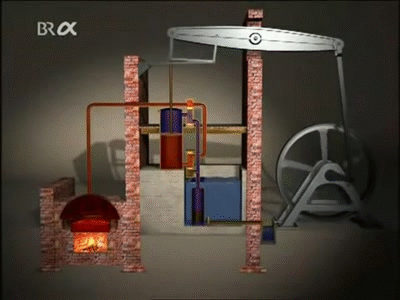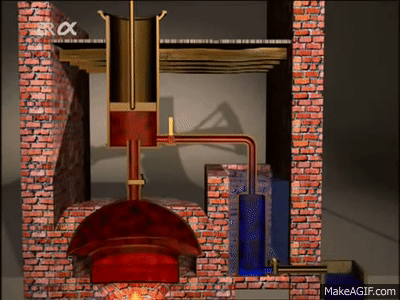Today (January 19, 1736) is the birthday of James Watt, who invented the first steam engine and ushered in the Industrial Revolution.

James Watt was born on January
19, 1736, in the port of Greenwich, Fifth Clyde. His father was a shipbuilder,
ship owner and contractor. Agnes Muirhead, the mother of James Watt, belongs to a
noble family. Well, read. Watt did not go to school properly. More interested in
drawing at a young age. Since there is no money to buy paper, he will draw on
the floor of the house. His paintings feature mathematics such as circles,
squares and triangles. Slightly weak at birth. Health is often affected. Unable
to attend school regularly, he studied at home with his mother. He became more
interested in learning mathematics. His mother died when he was 18 years old.
His father's health was also affected. Watt went to London to learn how to make
tools and returned to Scotland a year later. There he intended to start his own
tool making business. In 1759 John Robson, a friend of Watt, said that we
should focus on the use of steam as a source of propulsion.

The Newcommon steam engine has
been in use for almost 50 years to extract water from the mines without any
change in design. Although Watt never saw a running steam engine, he began
experimenting with steam. He tried to build a model. It failed to work
satisfactorily. But he continued his experiment. He started reading everything
about that steam engine. Watt began to realize the importance of latent heat.
In addition, Watt's friend Joseph Black discovered a few years ago how thermal energy generated during constant heat transfer is used to
operate a steam engine. In the field of thermal kinetic energy, the perception
of steam engine motion was in its infancy. And last for the next hundred
years without being formalized in the same condition.


In 1763, Watt was asked to repair
a model of a Newcom machine owned by the university. The machine barely worked
even after repair. After numerous experiments, Watt explained that one-third of
the heat energy obtained by steam in each cycle was used to heat the engine
cylinder. This thermal energy is wasted. This is because cold water was
injected to cool the steam to reduce the pressure inside the cylinder during
each cycle. This resulted in repeated heating and cooling of the cylinder
occurring at each cycle so that more heat energy was wasted without converting
the engine into more kinetic energy. Watt's most important discovery was made
in May 1765. The reason was that he cooled the heat of the steam in a separate
room outside the piston. This process was able to maintain a uniform heat
inside the engine cylinder because the cylinder was surrounded by a steam
jacket. Thus some small amount of energy is absorbed in each cycle and a large
amount of kinetic energy is available to do the useful work. In the same year, Watt developed a working model.


Despite a potentially workable
design, there were significant difficulties in configuring the full-scale
machine. This requires more capital. Some of it came from black money. Watt
received considerable support from John Roebuck. John Paulk is the founder of
the famous Caron Iron Workshop nearby. Watt formed an alliance with him. Robak
lived in Kinnell House in Ponnus. At the time, Watt was filming his steam
engine in a hut near Robak's house. That hut’s cage and wat still witness
huge projects today. In 1776, the first steam engines were installed and worked
in commercial establishments. These first machines were used for pumps to
provide pumping capacity. They only developed a single transmission motion to
move the pipe wires to the base of the shafts. This design was commercially
successful. Watt installed more machines for the next five years. Especially
founded to drain water from the mines at Cornwall.


These early machines were not
manufactured by Boulton and Watt. But Watt was made by others based on
drawings drawn by them. Watt worked only as their consulting engineer. The
start of the machines and their frequency was first supervised by Watt. Men were
then hired at the company to do the work. At first, these were big machines. For
example, a cylinder was 50 inches in diameter and 24 feet high. A separate
building was required to set up this machine. Bolton and Watt received
one-third of their annual income, the amount of coal stored by the new machine,
as money for their work. Watt has been honoured for as long as he has lived. In
1784 he was honoured as a member of the Royal Society of Edinburgh. He was also
elected a member of the Pattawian Society for Rotterdam's Recipe Philosophy in
1787.

In 1789 he was elected a member
of the high committee of the Smithsonian Society for Civil Engineers. In 1806
he was awarded an honorary doctorate in law from the University of Glasgow. He
was elected a recognized member of the French Academy and in 1814 was appointed
a foreign liaison. The International System of Units (or "SI"), a systematic
unit of measurement for watts, was formally named Watt after James Watt for his
contribution to the development of the steam engine. The unit was adopted in
1889 by the Second Congress of the British Society for the Advancement of
Science. Also in the 11th 1960s, the unit watt was incorporated into the International
System of Units ("SI"). On May 29, 2009, the Bank of England
announced that Poulton and Watt would be printed on its new 50-pound sterling
banknote. This is the first time in the history of Bank of England banknotes
that images of two persons have been printed. It was announced in September
2011 that the paper would go into circulation on November 2.


James Watt, the historian who
transformed natural steam power into an enormous force for mankind. James Watt,
who invented the first steam engine and ushered in the Industrial Revolution,
died in England on August 25, 1819, at the age of 83. Watt's body was buried on
the grounds of St. Mary's Church in Handsworth, Birmingham. It is believed that
his tomb is now buried beneath the church, as the church building was later
expanded over Watt's grave. In March 2011, as part of a new permanent science
museum exhibition entitled "James Watt and Our World" was put on
public display.
Source By: Wikipedia
Information: Dr. P. Ramesh, Assistant
Professor of Physics, Nehru Memorial College, Puthanampatti, Trichy.
Get information like this
https://t.me/joinchat/jpqj3jQLN51kYTk9
Join Telegram Group.
https://chat.whatsapp.com/FisIzCe4Br2CRgxAiicUnf
Join WhatsApp Group
Thanks.
Also, Read
🛑👍 CSIR-NET Physics Materials and Problems
🛑📕 21 GB and Hundreds of Physics E-Books Collection.
🛑🛥️ How does an Electric Motor work? (DC Motor).
🛑🤹♂️ Science Academies' Summer Research Fellowship Programme for Students and Teachers 2022.
🛑🔌 How does a Transformer work - Working Principle electrical engineering.
🛑🎙️ Transistors Explained - How transistors work.
🛑🔥⚡ How Thermocouples Work - basic working principle.
🛑🔌 Voltage Explained - What is Voltage? Basic electricity potential difference
🛑🔌 What is CURRENT– electric current explained, electricity basics.

.jpg)

No comments:
Post a Comment